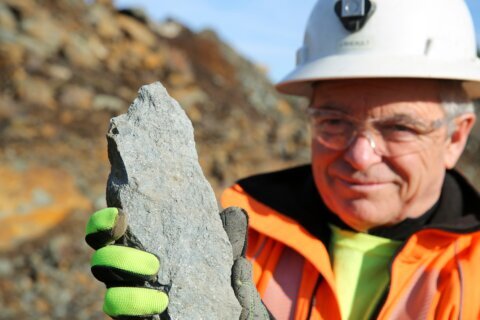At Arches National Park in southern Utah, Memorial Day Weekend is typically the busiest weekend of the year.
“All of the parking lots would be full; there’d be bumper-to-bumper traffic all along the road,” said Kaitlin Thomas, the public affairs specialist for Arches. “So, it just was a terrible experience for everybody involved, and not good for the park resources.”
Over the past two decades, crowds have more than doubled at the park. Last year, it received a record-breaking 1.8 million visitors – which meant a lot of days felt like Memorial Day.
Correspondent Conor Knighton asked, “How many times did you have to close that gate?”
“Oh, gosh, 158 times,” replied Thomas. “So, a lot!”
“And that’s for hours at a time, right?”
“Yes, yes.”
In the nearby town of Moab, reservations for hotels and restaurants are hard to come by. But this year, for the first time ever, the park itself is requiring reservations.
From April to October, tourists hoping to access Arches during peak hours need to have a ticket, obtained via Recreation.gov. Popular time slots can get booked up months in advance.
Thomas said, “With timed entry, the idea is that we take all of those visitors and we distribute them throughout the day, and throughout the season, so that we can hopefully mitigate the traffic and also improve those visitor experiences.”
Popular parks across the country are trying similar approaches. Rocky Mountain in Colorado is requiring timed entry reservations from now until October 10. In California, Yosemite requires them until the end of September.
At parks like Zion and Shenandoah, certain hikes now have to be scheduled. If you’re planning on driving up Acadia’s Cadillac Mountain to see the sunrise, or weaving through the mountains on Glacier National Park’s famous “Going to the Sun” road, you’re going to need to book in advance.
“For decades the national parks have done a really good job with wildlife management and landscape management and ecological management, and I think they’re just going to have to sort of turn their focus to people management,” said Brian Yablonski, the CEO of the Property and Environment Research Center. It has been studying a number of possible approaches to deal with the record-setting crowds.
Over the past decade, our 63 national parks have received 34% more visitors.
Brian Yablonski said, “We’re in uncharted territory when it comes to visitation. So, there’s a lot of room for experimentation and creativity.”
That could mean creating more shuttle bus systems, like the one already in place at Zion National Park. It could mean taking some cues from the theme park world, using technology to show what sites at a park are less crowded. And at some locations, it could mean reservations. While many of the timed entry programs are trial runs for now, they could become permanent.
“I think some of those parks are going to have to do the thing that might not be popular,” Yablonski said. “What we’ll lose in that process is spontaneity. I think Americans like to be spontaneous.”
Naturalist John Muir wrote, “The mountains are calling and I must go.” Not “The mountains are calling and I must go at 2 p.m. on a Wednesday because that’s the only ticket I could get.”
According to Moab developer Michael Liss, “The job of the National Park Service is to protect the land for the people. And it almost seems like the land is being protected from the people.”
Liss, who first fell in love with Arches on a spontaneous detour during a road trip decades ago, worries that people are on their own “spontaneous journey” won’t be so lucky: “The fact that you’d arrive here and couldn’t get into Arches, that’s really disappointing to me.”
And so far, under the new timed entry system, that’s happened to 10-15% of visitors. Tourists without reservation are asked to come back outside of peak hours, or to try the night before for one of several next-day tickets that are held back. But that might not work for everyone’s schedule.
Liss thinks more cars could be accommodated: “The infrastructure of Arches National Park was designed in the 1950s. They built the one entrance, one entry road. The parking lots have grown, you know, a little bit over the years, but substantially nothing has changed in 70 years. So, when I look at this, it’s like, isn’t it time to upgrade the park?”
Of course, building new entrances and parking lots costs money and takes time. There’s already a multi-billion-dollar maintenance backlog in our parks. Plus, the idea of continuing to “pave paradise” can be a tough sell.
Kaitlin Thomas said, “Here in the Park Service, we’re in the forever business. We protect these parks for perpetuity, and we want to make sure that we leave them just as they are for future generations.”
Thomas and the team at Arches have been encouraging visitors who show up without reservations to check out other beautiful destinations.
The story of overcrowded parks is mostly the story of a select group of super popular parks. There are plenty of other under-publicized places where you can still get away from it all.
According to Yablonski, 50 percent of visitors are crowding into six percent of our national parks.
According to National Park Service data, while Great Smoky Mountains National Park received more than 14 million visitors in 2021, 15 parks (including Guadalupe Mountains, Voyageurs, Denali, Dry Tortugas and North Cascades) each received fewer than a quarter-million visitors last year.
Only time will tell if these timed-entry systems will stick around … or expand to other sites.
Knighton asked Thomas, “What’s the feedback been so far from the visitors?”
“Oh, fantastic,” she replied. “We have folks saying that this is the best trip to Arches that they’ve ever had, if they’ve been here before. I think people are seeing that there’s an improved experience here and they’re having just better connections with the landscape while they’re visiting.”
That sense of connection is difficult to quantify. For now, by giving up some spontaneity, visitors have been getting a bit more solitude.
Story produced by Dustin Stephens. Editor: Emanuele Secci.







